This won’t be your average guide to Inner Mongolian dishes. As I look through different guides, I’ve noticed they say about the same thing: an emphasis on Roast Lamb and Barbeque. While this is true, I want to give you a special view of the dishes I personally ate with locals on a daily basis–dishes that don’t really have names in English. So, we’ll start with the lesser known dishes.
The cuisine of Inner Mongolia is heavily influenced by northern Han Chinese dishes, which makes Inner Mongolia a unique place. Northern dishes consist of lots of dumplings, noodles, buns, and pancakes, rather than rice; though rice dishes indeed exist.
As is commonly known, Inner Mongolian cuisine has a heavy emphasis on meat and dairy due to the lack of arable farming land and long, dry, harsh winters. Many vegetables that are traditionally consumed are vegetables associated with the climate: potatoes, string beans, corn, sweet potatoes, carrots etc. So how do they make up for the vegetables? My Mongolian friend told me that tea drinking makes up for it for the nutrients. Nowadays in Inner Mongolia, food from all over China—as well as the world—are imported. You can get just about anything. But let’s focus on the unique Chinese and Mongolian fusion that is Inner Mongolian Cuisine.
Flavors range from savory, to tame, to down-right spicy and sour. Most dishes are a balance of savory and sour flavors due to the need to preserve food for harsh winters.
Mongolian yogurt 酸奶 Suannai-
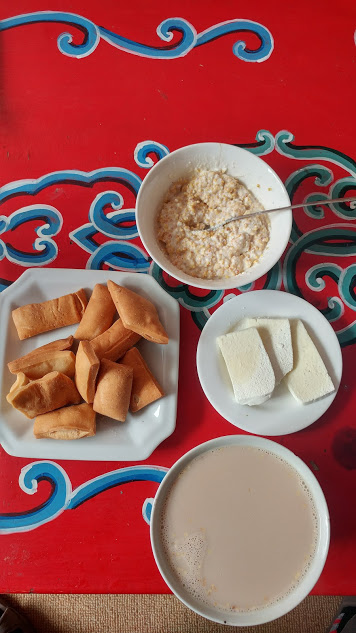
Unlike most of Asia, which does not heavily rely on traditional dairy products, Mongol culture emphasizes the use of dairy products from their livestock: cattle, yaks, goats and sheep. Yogurt for the most part is in liquid form and is treated as a beverage. Thicker variations of yogurt mixed with cheese (as in the picture) can be used as breakfast dishes. Fried millets and sugar are added in order to add a sweet and toasty flavor; as well as to add more volume. Below in the yogurt dish, you’ll see fried dough called guotiao (which I’ll introduce later), dried cheese, and milk tea. This picture above was my breakfast on a cold winter morning.
Mongolian Milk Tea Hot Pot
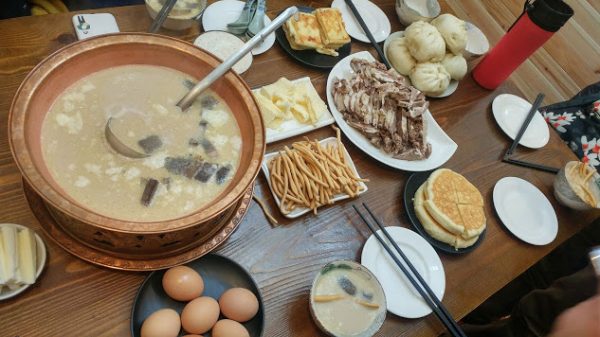
Mongolian hotpot is very unique: instead of spiced broth to boil their meat and vegetables, they use milk tea. It is quite common to put lamb, beef, vegetables, and fried dough (粿条)Guotiao into the milk tea to boil before eating. As shown in the picture, Mongolians will eat a variety of dried cheeses, fried dough, pancakes, and buns stuffed with spiced lamb. Instead of a bowl of rice, you will have a bowl of savory hot milk tea to eat and drink out of.
撒子/粿条 sazi and guotiao
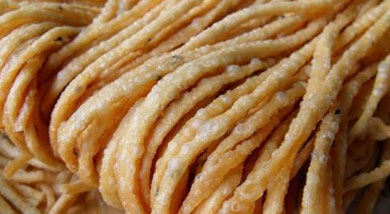
Sazi and guotiao are different types of crunchy fried dough that are eaten with warm milk tea and cheese. It is a kind of crispy snack in Inner Mongolia. You can choose salty or sweet varieties. Most of the time people eat them for breakfast. People cut the dry dough into short sticks around 5-7cm and fry them in oil. There are many varieties of dried and fried snacks eaten with milk tea. The last picture is a special treat during the Mongolian Winter Nadaam Festival.
烩菜- Huicai
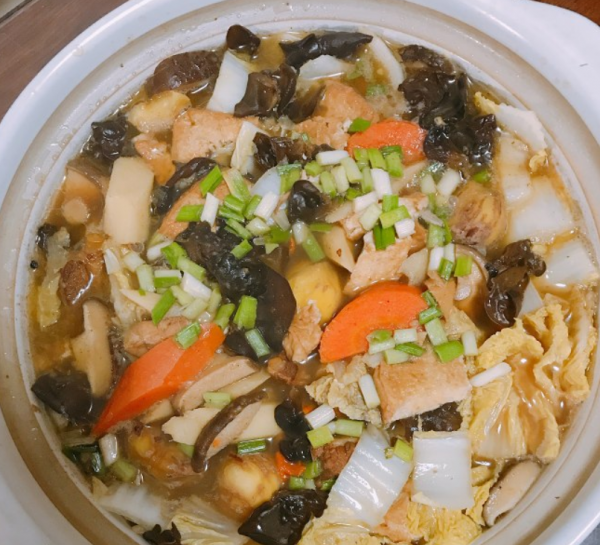
Huicai is essentially boiled potatoes, string beans, carrots, and other various pickled vegetables, sometimes with braised meat. Certain dishes emphasize toasted bread. Others have sour pickled vegetables.
巴盟铁锅烩菜- Bameng Tieguo Huicai
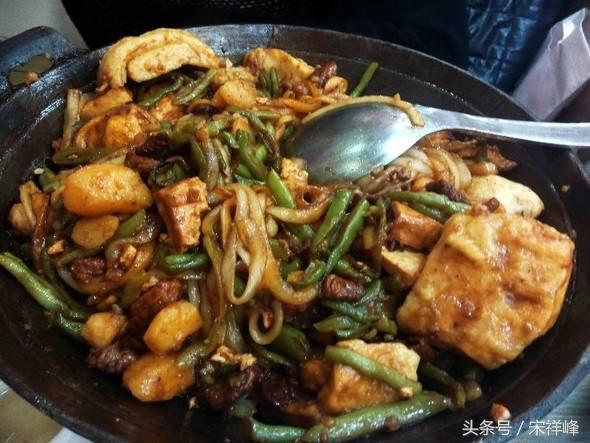
This specialty iron plan-stir fried variation is specially attributed to the small Inner Mongolian city of Bameng. It contains toasted bread on the sides
烩酸菜- Suan HuiCai
The Suan Hui Cai version of Huicai, as its name indicates, contains more sour and pickled vegetables.
焖面 MenMian
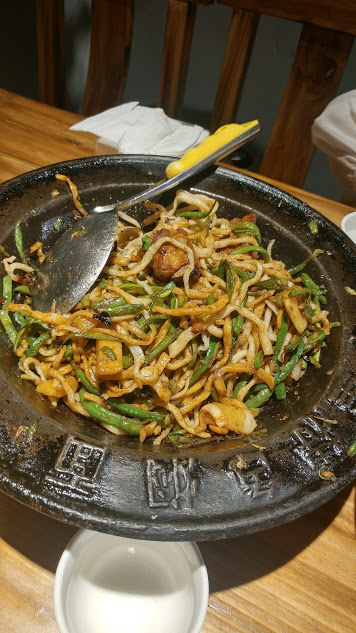
These are noodles boiled over a slow fire and are included in dishes such as 排骨焖面 Paigu menmian, which contains pork rib as seen above
羊杂碎 Yangza Sui
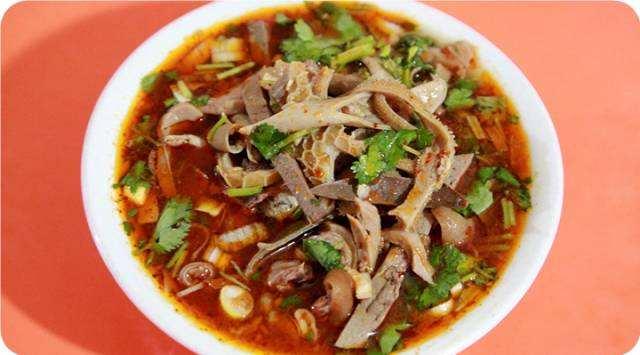
This is a personal favorite of mine and roughly translates as “Lamb Innards Soup” Yes, you heard that right! These are all the other parts of the animal that Western cuisines usually waste: Lungs, stomach, intestines, liver, and kidneys all chopped up and put into a soup! The broth itself that naturally results in the simmering of these ingredients with parsley, onions, and pepper is a joy to sip in freezing weather. So next time you have a friend that believes we should use the entire animal, order them this soup for lunch!
Mongolian Barbecue 烤羊肉/烧烤
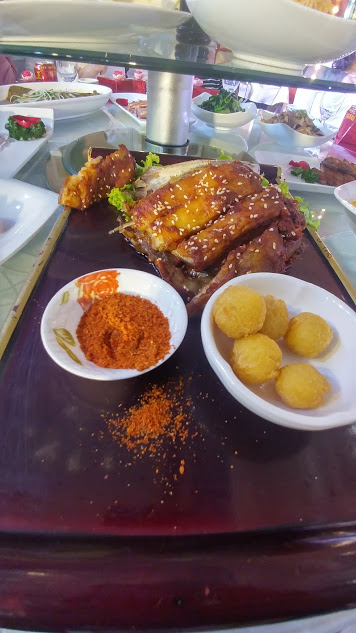
Here we go! This is what I will write the least about, partly because it is self-explanatory and partly because you can find so much repetitive information about Mongolian Barbeque. Lamb is the primary meat used. They use the entire lamb too.
Mongolian Baijiu, Manaijiu 白酒,马奶酒
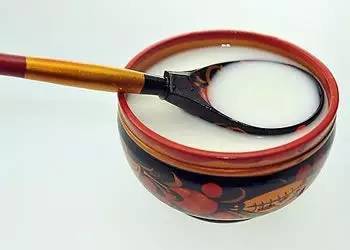
Inner Mongolians typically drink Baijiu (white liquor) which is typical in China. The most famous brand that I saw while living in Batou, Inner Mongolia was 蒙古王. Menggu Wang literally means “Mongolian King”, referring to Genghis Khan. There are many wide varieties of brands. 马奶酒 Manaijiu, which is a Mongolian liquor made from horse milk is popular also. Though I was told that this Mongolian liquor resembles milk in appearance, the Manaijiu that I tried was almost the same as Baijiu in terms of flavor, strength, and appearance. People of Inner Mongolia also make homemade Baijiu which I personally like to call “Mongolian Moonshine”. It’s the most intense alcohol I’ve ever experienced, as it gets stronger as you drink it. I recalled having minor hallucinations from this experience.
Huang He Fish 开河鱼
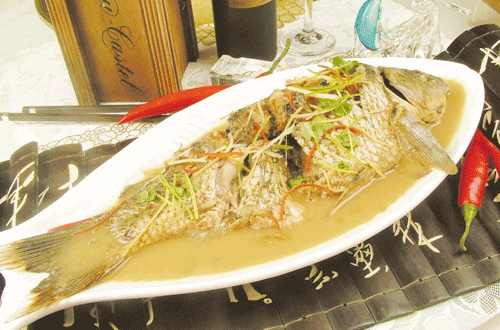
Inner Mongolians have a spring tradition of eating steamed/boiled fish. As the bitter cold winter ends, carp start migrating up the Yellow River which winds through the Inner Mongolian Plains. The fish is served whole, including the bones and head, and is smothered in a savory soybean sauce. The best parts of the fish to eat are supposedly the cheeks.
Before boiling the fish, they pan fry it. Then seasonings, soybean paste, and tofu are added, then boiled. People in Inner Mongolia like to eat salty food, so the flavor is not light at all.
烧卖 Shaomai
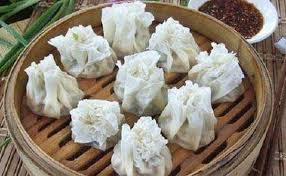
Shaomai are small dumplings which originated from Inner Mongolia’s Capital, Hohhot. The Shaomai you may have tried are more famously based off Cantonese recipes. There are many variations of Shaomai in Inner Mongolia, but most variations I have tried contain lamb, onion, and scallions with a soupy broth inside. It’s not as soupy as the 小笼包 xiaolong bao soup dumplings in Shanghai, but you definitely have to be careful before biting into one!
茶汤 Cha tang
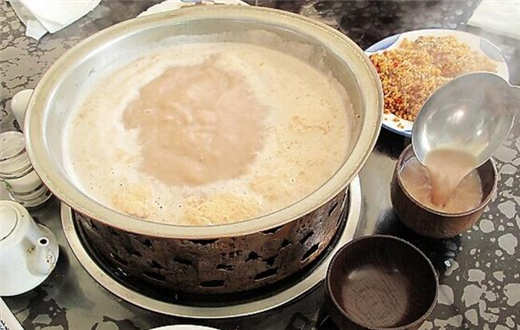
No two servings of Cha tang are exactly the same. This soup consists of flour, sugar, and an assortment of dried fruits. Despite the literal translation, Cha tang is not “tea soup”. The preparation process is similar to tea, as well as the soup having a tea fragrance. In addition, you can add brown sugar, crushed peanuts, and sesame seeds on top. Cha tang is usually eaten as a dessert or snack.
呼市焙子: Hushi Beizi
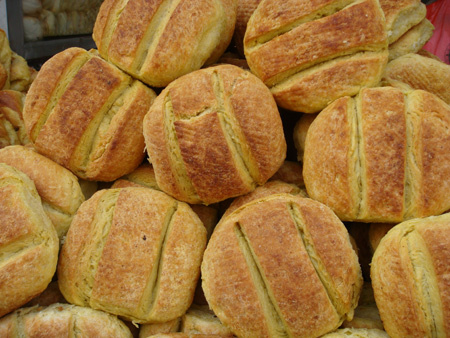
Beizi is an Inner Mongolian street food specialty.“呼市” is local slang for Hohhot, the capital of Inner Mongolia. It’s essentially a roasted bun with fried eggs, sausages, pickled vegetables and potatoes. Originating in Hohhot, this is present everywhere. During my stay in Baotou, I would get one order of Beizi early in the morning for a quick breakfast. If I was still sleepy, I’d ask the elderly woman selling me beizi to add extra chili sauce! It keeps you surprisingly full until lunch.
Liang Cai 凉菜:
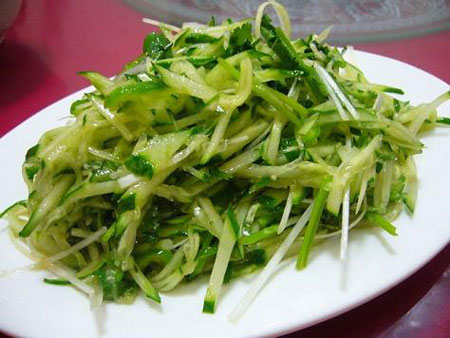
Typical cold dishes for appetizers come in all sorts of varieties. Most contain some form of pickled vegetables with vinegar, peanuts, and 豆腐皮 dofu pi which is tofu that has been made into a noodle-like form.
莜面 Youmian
Youmian is one of the local specialties in Baotou. It is made with a kind of oat flour. People use this flour to make many different kinds of food. They make it into noodles, dumplings, pancakes, and cakes.
The noodles made of youmian have variety shapes. They come in tubular shapes as well as long noodles. Inner Mongolians also make it into small fish shapes which is called youmian yuyu( 鱼鱼). No matter what shape it is, we need to steam them before cooking. Here are three popular ways for cooking the noodles.
- 凉拌莜面 liangban youmian – People mix the steamed noodles with mashed potatoes. Add some cucumber and bean sprouts. Sauce includes salt and vinegar.
- 炒莜面 chao youmian – Youmian can be made into a fried dish. Most of the fried youmian dishes include some vegetables such as tomato, potato or cabbage.
- 莜面汤 youmian tang – One traditional way of eating youmian is to accompany it with soup. You can dip the youmian into the soup while you sip on it. It doesn’t matter if the soup is warm or cold, both are satisfying.
The cold one includes cucumber, radish, tomato, and cilantro. The soup is mixed with sesame oil and a little vinegar. The hot soup is made of mutton, potatoes, and mushroom.
Fried dumpling (Khuushuur)
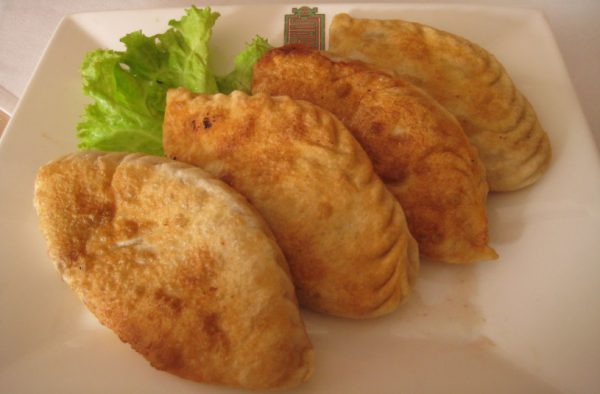
This is a Mongolian version of fried dumpling. It usually consists of lamb, black pepper, salt, and cumin powder. It’s a very popular snack as well as an appetizer.
If you would like to sample these foods first hand with locals, then don’t forget to check out our Ordos, Inner Mongolian tours as well as our joint tours to the Republic of Mongolia itself for Nadaam Festival! Check out the links below:





